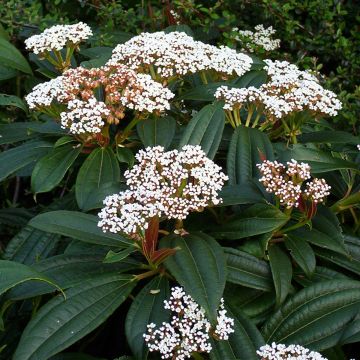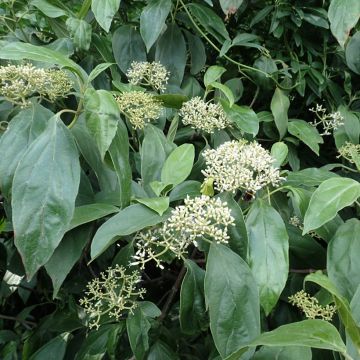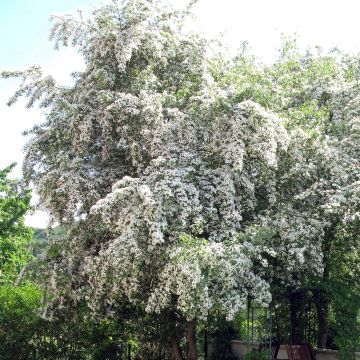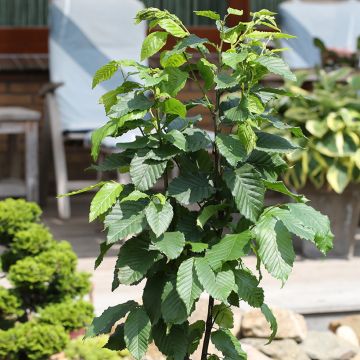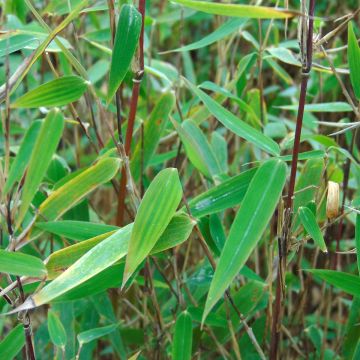

Viburnum carlesii Aurora


Viburnum carlesii Aurora
Viburnum carlesii Aurora
Viburnum carlesii Aurora
Korean Spice Viburnum, Judd viburnum
This item cannot be shipped to the selected country
Delivery charge from €5.90
More information
Schedule delivery date,
and select date in basket
This plant carries a 24 months recovery warranty
More information
We guarantee the quality of our plants for a full growing cycle, and will replace at our expense any plant that fails to recover under normal climatic and planting conditions.
From €5.90 for pickup delivery and €6.90 for home delivery
Express home delivery from €8.90.


Does this plant fit my garden?
Set up your Plantfit profile →
Description
Viburnum carlesii 'Aurora' is an interesting variety of Viburnum carlesii bred for its more compact habit and slightly more colourful flowering. For the rest, this shrub with a nicely rounded habit possesses the same ornamental qualities as its parent: a pleasantly fragrant early spring flowering, beautiful autumn foliage, and lots of charm. It can be planted as a hedge, in the back of a border, or as a specimen near the house to fully enjoy its beautiful flowering.
Viburnum carlesii 'Aurora' is a horticultural cultivar from Slieve Donard (Northern Ireland) dating back to 1950. Its wild ancestor, Viburnum carlesii, is native to Korea and Japan. This 'Aurora' variety is a deciduous shrub of the Caprifoliaceae family, very hardy, moderately fast growing, with a rounded habit, reaching about 2m (7ft 6in) in all directions at maturity. Around the month of April, while its young leaves unfold, it becomes covered with flowers arranged in round clusters measuring 10-12cm (3.9 - 4.7in) in diameter. The red flower buds open into small white flowers with pale pink reverses, exhaling a scent of hyacinth and orange blossom. Its foliage, well-filled, consists of crinkled and toothed leaves reaching 11cm (4.3in) in length. Green-bronze in colour, they turn into shiny dark green before becoming yellow and then orange-red in autumn before falling.
Like all viburnums, Viburnum carlesii 'Aurora' is a hardy and easy-to-grow shrub in non-limestone soil. It can be planted as a specimen in a small garden, or as a hedge or in a border in larger gardens. Its inflorescences can be used in bouquet arrangements. Consider planting it in a high-traffic area to fully enjoy its fragrance, under a window or near a door, for example. It can be combined with many other flowering shrubs, foliage plants, or decorative fruit-bearing plants: Japanese maples, Garlic Mustard, Paniculate Hydrangeas, Star Magnolia...
Report an error about the product description
Plant habit
Flowering
Foliage
Botanical data
Viburnum
carlesii
Aurora
Caprifoliaceae
Korean Spice Viburnum, Judd viburnum
Cultivar or hybrid
Other Viburnum
Planting and care
Viburnum carlesii 'Aurora' can be grown in full sun or partial shade. Place it from November to May, frost-free, in a preferably acid to neutral and not too dry soil, ideally humus-rich and always slightly moist. Improve the soil in your garden if necessary with compost and heath soil. At the beginning of its establishment, ensure good regular watering (except during freezing periods) and mulch the soil in spring. Prune after flowering to maintain a compact habit.
Viburnums are sometimes infested with black bean aphids (Aphis fabae), a parasite that also overwinters on Euonymus and is a vector of the Cucumber virus, which causes mosaic disease. The leaves are occasionally ravaged by a leaf beetle: spray with pyrethrum as soon as yellow larvae with black spots appear. Powdery mildew, rot, and leaf spots can affect viburnums.
Planting period
Intended location
Care
-
, onOrder confirmed
Reply from on Promesse de fleurs
Hedge shrubs
Haven't found what you were looking for?
Hardiness is the lowest winter temperature a plant can endure without suffering serious damage or even dying. However, hardiness is affected by location (a sheltered area, such as a patio), protection (winter cover) and soil type (hardiness is improved by well-drained soil).

Photo Sharing Terms & Conditions
In order to encourage gardeners to interact and share their experiences, Promesse de fleurs offers various media enabling content to be uploaded onto its Site - in particular via the ‘Photo sharing’ module.
The User agrees to refrain from:
- Posting any content that is illegal, prejudicial, insulting, racist, inciteful to hatred, revisionist, contrary to public decency, that infringes on privacy or on the privacy rights of third parties, in particular the publicity rights of persons and goods, intellectual property rights, or the right to privacy.
- Submitting content on behalf of a third party;
- Impersonate the identity of a third party and/or publish any personal information about a third party;
In general, the User undertakes to refrain from any unethical behaviour.
All Content (in particular text, comments, files, images, photos, videos, creative works, etc.), which may be subject to property or intellectual property rights, image or other private rights, shall remain the property of the User, subject to the limited rights granted by the terms of the licence granted by Promesse de fleurs as stated below. Users are at liberty to publish or not to publish such Content on the Site, notably via the ‘Photo Sharing’ facility, and accept that this Content shall be made public and freely accessible, notably on the Internet.
Users further acknowledge, undertake to have ,and guarantee that they hold all necessary rights and permissions to publish such material on the Site, in particular with regard to the legislation in force pertaining to any privacy, property, intellectual property, image, or contractual rights, or rights of any other nature. By publishing such Content on the Site, Users acknowledge accepting full liability as publishers of the Content within the meaning of the law, and grant Promesse de fleurs, free of charge, an inclusive, worldwide licence for the said Content for the entire duration of its publication, including all reproduction, representation, up/downloading, displaying, performing, transmission, and storage rights.
Users also grant permission for their name to be linked to the Content and accept that this link may not always be made available.
By engaging in posting material, Users consent to their Content becoming automatically accessible on the Internet, in particular on other sites and/or blogs and/or web pages of the Promesse de fleurs site, including in particular social pages and the Promesse de fleurs catalogue.
Users may secure the removal of entrusted content free of charge by issuing a simple request via our contact form.
The flowering period indicated on our website applies to countries and regions located in USDA zone 8 (France, the United Kingdom, Ireland, the Netherlands, etc.)
It will vary according to where you live:
- In zones 9 to 10 (Italy, Spain, Greece, etc.), flowering will occur about 2 to 4 weeks earlier.
- In zones 6 to 7 (Germany, Poland, Slovenia, and lower mountainous regions), flowering will be delayed by 2 to 3 weeks.
- In zone 5 (Central Europe, Scandinavia), blooming will be delayed by 3 to 5 weeks.
In temperate climates, pruning of spring-flowering shrubs (forsythia, spireas, etc.) should be done just after flowering.
Pruning of summer-flowering shrubs (Indian Lilac, Perovskia, etc.) can be done in winter or spring.
In cold regions as well as with frost-sensitive plants, avoid pruning too early when severe frosts may still occur.
The planting period indicated on our website applies to countries and regions located in USDA zone 8 (France, United Kingdom, Ireland, Netherlands).
It will vary according to where you live:
- In Mediterranean zones (Marseille, Madrid, Milan, etc.), autumn and winter are the best planting periods.
- In continental zones (Strasbourg, Munich, Vienna, etc.), delay planting by 2 to 3 weeks in spring and bring it forward by 2 to 4 weeks in autumn.
- In mountainous regions (the Alps, Pyrenees, Carpathians, etc.), it is best to plant in late spring (May-June) or late summer (August-September).
The harvesting period indicated on our website applies to countries and regions in USDA zone 8 (France, England, Ireland, the Netherlands).
In colder areas (Scandinavia, Poland, Austria...) fruit and vegetable harvests are likely to be delayed by 3-4 weeks.
In warmer areas (Italy, Spain, Greece, etc.), harvesting will probably take place earlier, depending on weather conditions.
The sowing periods indicated on our website apply to countries and regions within USDA Zone 8 (France, UK, Ireland, Netherlands).
In colder areas (Scandinavia, Poland, Austria...), delay any outdoor sowing by 3-4 weeks, or sow under glass.
In warmer climes (Italy, Spain, Greece, etc.), bring outdoor sowing forward by a few weeks.



































